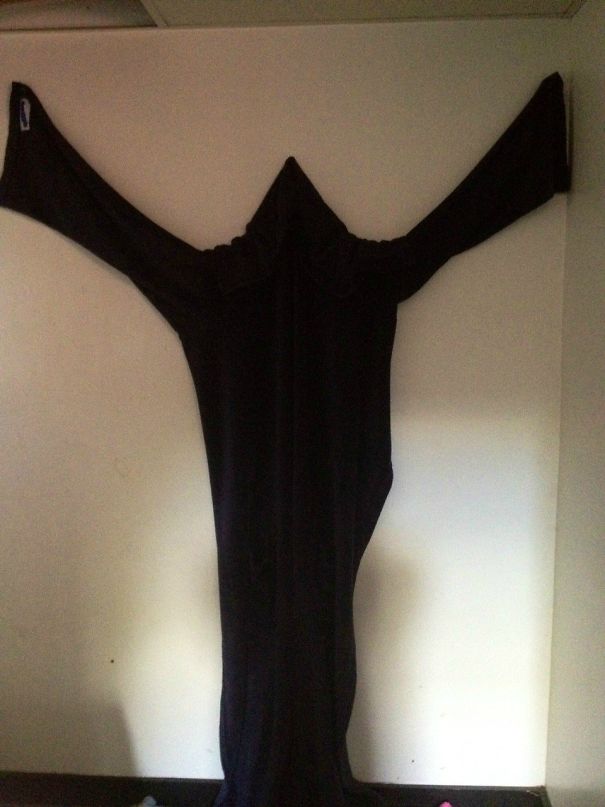Maybe we watched too many horror movies as kids, or maybe it’s just an evolutionary advantage to be wary of danger when it isn’t necessarily there, but we can all remember that sudden feeling of terror when the shadow of a tree flashes across a window.
“Who’s there!” Is our first reaction. Because we are programmed to see faces and other human features quickly, that innocent branch swaying in the wind can quickly become the sinister hand of an ax murderer. It works for other threats too. Are you afraid of spiders? Then perhaps you might begin to ‘see’ them everywhere until you get a closer look and realize that it’s just a hairclip. Better to be safe than sorry though, am I right?
We here at Bored Panda have compiled a list of times when people got freaked out by everyday things and while some of them are understandably scary, others are just plain hilarious. Scroll down below to check them out for yourself, and share your own stories in the comments!
That Paralyzing Moment When You Forget To Breathe Because You’re So Darn Scared… I Forgot I Put My Hair Clip There

Optical illusions challenge our sense of reality; they make us realize that what we see is simply our brains’ best interpretation of the visual cues our eyes provide. Our brains have adapted not to see what is actually there, but what we deem as useful to see.
Optical illusions occur when a visual scene unfolds that is different from what our brain has decided is the norm, and it will respond in odd and often confusing ways until finally arriving at a conclusion.
I Need To Find The Lady Who Hanged This Freak. Gave Me A Heart Attack…

I Thought I Saw A Woman Dressed As A Handmaid About To Jump From A Building. I Called 911

According to Exploring optical illusions, there are 3 main types of optical illusion:
Literal illusions create images that are different from the objects that make them, like most of the entries on this list. For example, if 3 birds are flying, 2 above one, it can form the illusion of a smiling face.
Physiological illusions, such as afterimages following bright lights or adapting stimuli of excessively longer alternating patterns (contingent perceptual aftereffect), are presumed to be the effects on the eyes or brain of excessive stimulation of a specific type – brightness, tilt, color, movement, etc. The theory is that stimuli have individual dedicated neural paths in the early stages of visual processing, and that repetitive stimulation of only one or a few channels causes a physiological imbalance that alters perception.
Slept Over My Moms House Last Night And This Scared Me More Then I Would Like To Admit

I Left My Boots At The Back Door. When I Was Walking Back Outside I Nearly Had A Heart Attack

Cognitive illusions are assumed to arise by interaction with assumptions about the world, leading to “unconscious inferences”, an idea first suggested in the 19th century by Hermann Helmholtz. Cognitive illusions are commonly divided into ambiguous illusions, distorting illusions, paradox illusions, or fiction illusions.
Ambiguous illusions are pictures or objects that elicit a perceptual ‘switch’ between the alternative interpretations. The Necker cube is a well known example; another instance is the Rubin vase.
Distorting illusions are characterized by distortions of size, length, or curvature. A striking example is the Café wall illusion. Another example is the famous Müller-Lyer illusion.
Paradox illusions are generated by objects that are paradoxical or impossible, such as the Penrose triangle or impossible staircases seen, for example, in M. C. Escher’s Ascending and Descending and Waterfall. The triangle is an illusion dependent on a cognitive misunderstanding that adjacent edges must join.
Fictional illusions are defined as the perception of objects that are genuinely not there to all but a single observer, such as those induced by schizophrenia or a hallucinogen. These are more properly called hallucinations.
Walked Into My Room And Saw That My Pillows And Blanket Had Tangled Up Like This. I Almost Had A Heart Attack

Had A Mini Heart Attack When I Looked Up And Saw This. Trampoline Developed A Hole. She Thought It Was Hilarious

This Was On The Side Of My Friends House, Scared The Crap Out Of Me

My Wife Tossed A Comforter On A Chair To Dry, I Nearly Had A Heart Attack

Saw This After My SO Gasped. Scared The Hell Out Of Us. This Is Mannequin

My Friend’s Way Of Drying Shoes Scared Me A Bit. I Thought She Was Hanging Out Her 11th Floor Window

“Head” On Beach After Sandy

When Your Lamp Gives You A Heart Attack

Hung My Hip Waders Up In The Basement. Scared The S**t Out Of My Wife When She Went To Go Down There

Every Time I Come Home Late My Neighbor’s Burglar-Proofing Cardboard Cutout Gives Me A Minor Heart Attack

Early When I Arrived Home, I Saw A Strange Figure Standing In My Window. Terrified, I Called The Police And They Did A Search Of My House. The Culprit? My Hanging Laundry

Came Home Late And Found This Sitting On The Edge Of My Bed. I Now Know What It’s Like To Be Too Scared To Move

Was Eating A Packet Of Walnuts When I Happened To Notice This… Almost Had A Heart Attack

Scared The Crap Out Of Me This Morning

Almost Had A Heart Attack

My Mom Washed My Snuggie And Hung It Up In My Room, Almost Had A Heart Attack

The Shadow From This Tree Scared Me


Leave a Comment